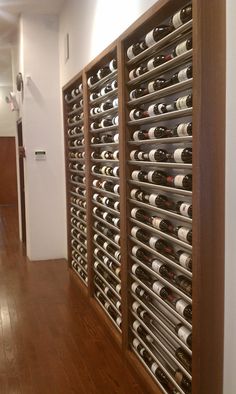
All About Storing Wine
Wine is probably one of the commonest consumer items we buy with a view for using it later than the day it was purchased. OK, there’s been many an occasion where a trip to the shops for a quick cheap bottle of plonk to accompany a last minute dinner date has been perfectly acceptable, but when you see a good (or even half-good) wine at a sensible price, the temptation is very much there to keep it for later, to have at a special time with important people. Going beyond this to serious wine collecting, there is going to come a point in time when the huge rack you bought for the kitchen is continuously full, as is the one for the garage, and sights are turning to a more “industrial scale” solution to one’s vino obsession.
Wine manufacturers take great pride in delivery a high quality product that delivers aroma, palette and aftertaste to showcase the fermented grapes in their best form, something that is inherently a pleasure to drink. Like other alcoholic beverages, and especially like the living products such as bottle primed real ale, flavour and body development may occur to certain wines when kept over time. So you could not just be storing wine for stock keeping and excessive purchase, but also to encourage or to mellow out certain aspects of the flavours. More information on why ageing is done and which wines respond well to ageing can be found over here.
Wine is traditionally kept in large cellars, underground cool caves that all-year-round exhibit the ideal conditions for maintaining the standard of the product. As you will know, wine is a particularly delicate alcoholic drink and if you don’t look after it, the end result may not be entirely what the manufacturer had in mind, or worst case it might be spoilt. Those of us with a spacious cellar at home might be able to attempt to replicate the traditional methods of wine storage, but it would be worth first of all exploring why the vineyard cellar has worked for keeping wine in storage for so long.
The key to the cellar’s success in keeping wine in top notch condition is one of evenness and consistency. The coolness of the cellar surroundings prevents outside heat from causing reactions in the wine that will result in too fast ageing and, in more pronounced cases, a notable loss of freshness and distinctiveness of flavour. This doesn’t mean that you should keep wine as cold as you can get away with either. Very cold and breezy conditions will cause degradation to the cork, allowing hungry airborne germs to enter the bottle resulting in something far from drinkable. The key therefore is to aim for a steady 12-13 Celsius, and somewhere in the region of at least 60% humidity to retain the moisture in the cork (storing bottles on their side also helps). If you aren’t getting the humidity, simply introduce a small amount of water into the room where the bottles are being stored. No, keeping wine in the fridge will not do, at least not in the long term.
The other important quotient to efficient wine storage is darkness. Light, particularly sunlight, can age wine too quickly, much like heat can, so you ideally don’t want to keep it in view of any windows or electric lighting. Dark cool cupboards and cellars are again ideal. The bottle in itself partly protects this, usually being deeply coloured.
Some self storage companies have seen a gap in the market here, and offer dedicated solutions for storing wine at controlled temperature and atmospheric conditions. So if you find yourself at the helm of a big occasion that requires a huge compliment of wine, or have acquired a beautiful collection of the fine stuff, then this could be the best way of keeping the drinks stored until the day they can be savoured. Perhaps even arrange yourself a tasting party in your unit! 🙂
Posted in: Storage Info


